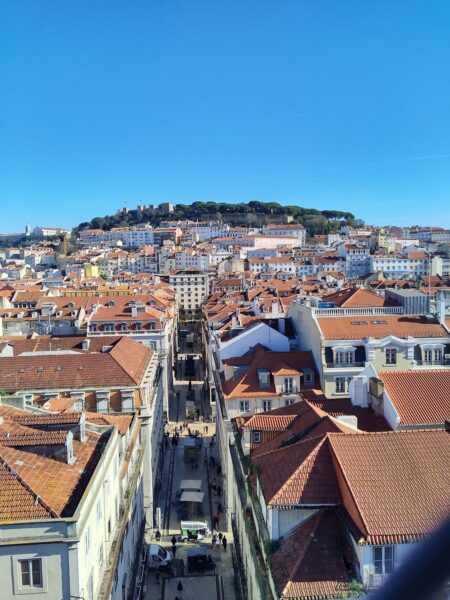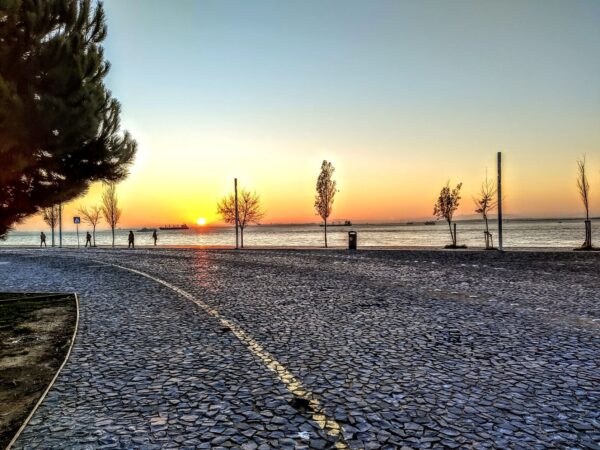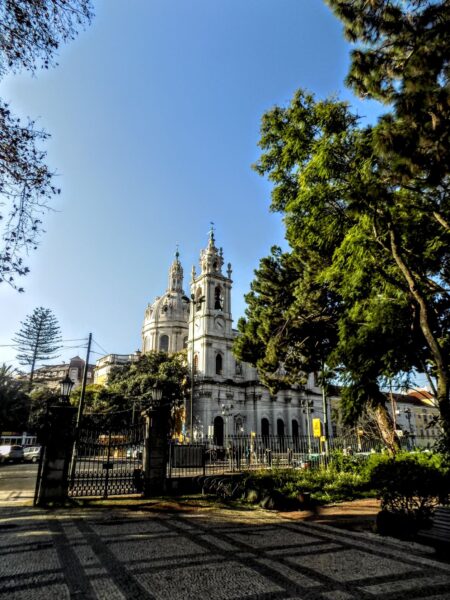I didn’t create the off-color acronym that some people apply to Thursday but I certainly was so happy this day had arrived. Today was the day I’d spend with my now amiga, Ana.
(If you’ve been reading along and are wondering what happened to Wednesday, I have an answer. Unlike the New Year’s Day washout, I slotted this Wednesday as one more opportunity to have a full experiment in daily living. If I choose to make Lisboa my second home, I’m certainly not going to engage in some daily sightseeing activity there any more than I do here in the DMV. So, while I didn’t spend the day lounging on the couch chilling in my Snuggie, I did little more than take a few long walks and spent much of the day at the apartment doing exactly what I’d do at home.
The main differences between this Wednesday and a normal day at home are that at home I walk through a nearby park to enjoy the greenery and accumulate my daily steps. In Lisboa, I typically walked with a destination or purpose in mind. My first walk Wednesday was to see how much I could duplicate the tour I’d had with Ana in May. I think I did a fair job as evidenced by the second difference. I took photos

and that’s something I rarely do at home. The other pictures I snapped are here.)
This Thursday morning I didn’t sleep in. I was excited to see Ana but I wanted to get in a vigorous walk before I did. I knew we’d spend much of the day on our feet but I also knew the pace would be leisurely. So while I walked an impressive 17.7 km for the day, my pace ended at a slow 12 and a half minutes per kilometer. (I’ll save you the math. This equates to roughly 11 miles and a sluglike 20:20 minutes per mile – about four and a half minutes slower than my normal pace.) The early morning walk did bring a nice view of the sunrise over the Tejo.

Hey there.
Ana arrived a bit past 09:00 and I appreciated her effort in getting into the city from her home near Cascais because there was a transit strike that day. Long distance trains were on an unreliable schedule and she had to walk from Cais do Sodré to meet me outside my apartment. While I was waiting, I took this picture to send to my pal JF.

(You might recall from the first post about the travel day, that he had given me this bag to replace one of mine that had worn out to the point that it was no longer usable. As a sort of running joke, I’d text him a picture of the bag in every airport I passed through and I thought he also deserved a picture of the bag in Lisboa. This is one of two from today – and I think you’ve seen it before.)
I’d put together an ambitious list of places to see knowing full well that we wouldn’t reach them all but that whatever we did we’d have a full day. We started with a walk up the hill through the now familiar neighborhood of Chiado to the small park that I referred to by its colloquial name Estrela (meaning star) but that is officially called the Jardim Guerra Junqueiro.
I think Ana was a little puzzled by my choice since, while the garden is favored by locals and, as Ana told me while we were there, is often a site for children’s play dates, it’s quite small, a mere 180 years old, and not of any particular historical or architectural importance. I don’t think she remembered that she’d told me in an email that this was a park where one might find artists painting en plein air. When I reminded her of this, she smiled and told me that the day was far too chilly to find active painters. (For the record, the temperature was definitely above 10°.)
On leaving the park we did get a look at the Basilica da Estrela.

Ana told me a bit about its history as we waited for the #25 Tram that we’d take to the Praça do Comércio to begin a walk into Alfama. Construction of this late baroque and neoclassical style cathedral began in 1779 as a fulfillment of a vow made by Queen Maria the First. After her wedding to her uncle Dom Pedro III, she promised to build a cathedral and convent dedicated to the Carmelite Order of Santa Teresa if she bore him an heir to the throne. Since she made her vow in front of an image of the Sacred Heart of Jesus, this became the first church in the world dedicated to this Catholic ritual.
She gave birth to a son in 1761. Sadly, he died of smallpox in 1788 during the basilica’s construction. Maria succeeded her father, José the First in 1777 and ruled until her death in 1816. In an interesting side detail, according to her biographical page in Wikipedia, the queen was known as Maria the Pious in Portugal but as Maria the Mad in Brazil.
Eyesight to the Blind.
I found it interesting that, after our visit to Estrela, Ana and I got off the tram very near the spot where we’d finished our tour in May because my first stop after that half day excursion was to walk to the Casa do Bicos the home of the Fundação José Saramago (José Saramago Foundation).

(Picture from May).
We stood in front of this survivor of the 1755 earthquake happily chatting away and meandering from one subject to another and back again. (It was here that she told me about the slang meaning of bico.) The main focus of our conversation centered mainly on Saramago’s interesting personal history and his writing that Ana finds simultaneously fascinating, compelling, and disquieting.
Saramago was both an atheist and a libertarian communist – neither of which endeared him to the clerical or political establishment. In 1991, although it is nominally a secular country, the Portuguese government removed his name from consideration for the European Literature Prize saying that his atheist work The Gospel According to Jesus Christ offended the Catholic convictions of the Portuguese people.
Later, when the Nobel Committee awarded Saramago the 1998 Prize for Literature, the Vatican criticized his selection as being political in nature without ever commenting on the aesthetic value of his writing. He responded by suggesting that the people in the Vatican, “should just focus on their prayers and leave people in peace. I respect those who believe, but I have no respect for the institution,” he said.
We went on to talk about the density of his writing, some of his stylistic quirks, and how his success came late in life. Saramago, born in 1922, essentially published nothing until the fall of the Salazar dictatorship. Ana talked at some length about one of his novels in particular called, in Portuguese Ensaio sobre a Cegueira and in English, Blindness. The novel, about a pandemic in which all the characters save one are stricken with blindness has a particular resonance today after the widespread impact of Covid-19.
She encouraged me to read this and some of his other work. I told her that I’d consider it but that I read very little fiction, struggle with translations, and have a stack of eight books awaiting me when I return home. (As I write this, I’ve finished two and have started a third that’s rather heavy in its subject matter and likely to be slow going.)
From there, we set off to explore a bit of Alfama on our way up the hill to the the Igreja de Sao Vicente da Fora (Church of Saint Vincent Outside the Walls) and the National Pantheon.